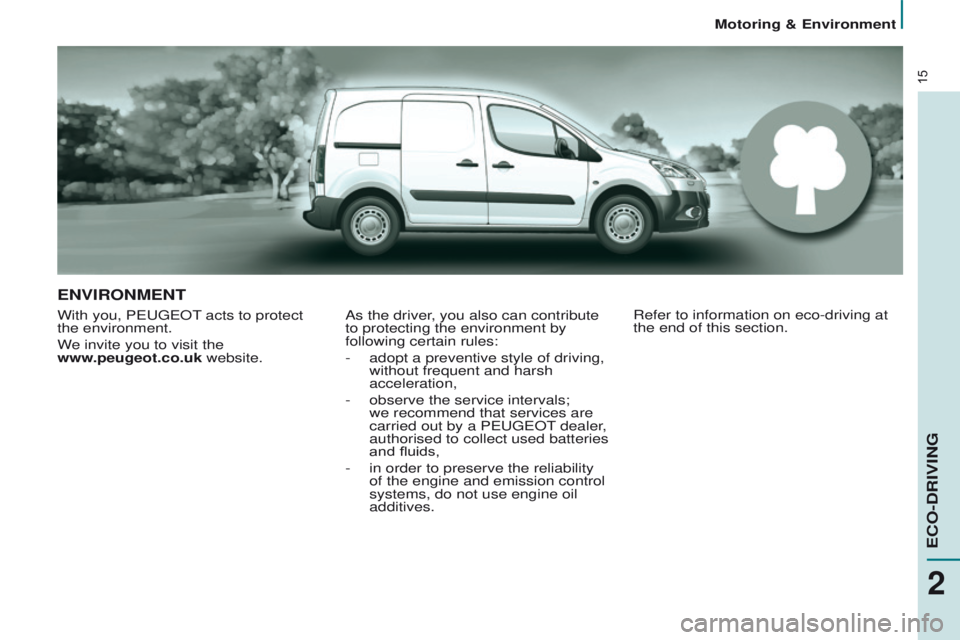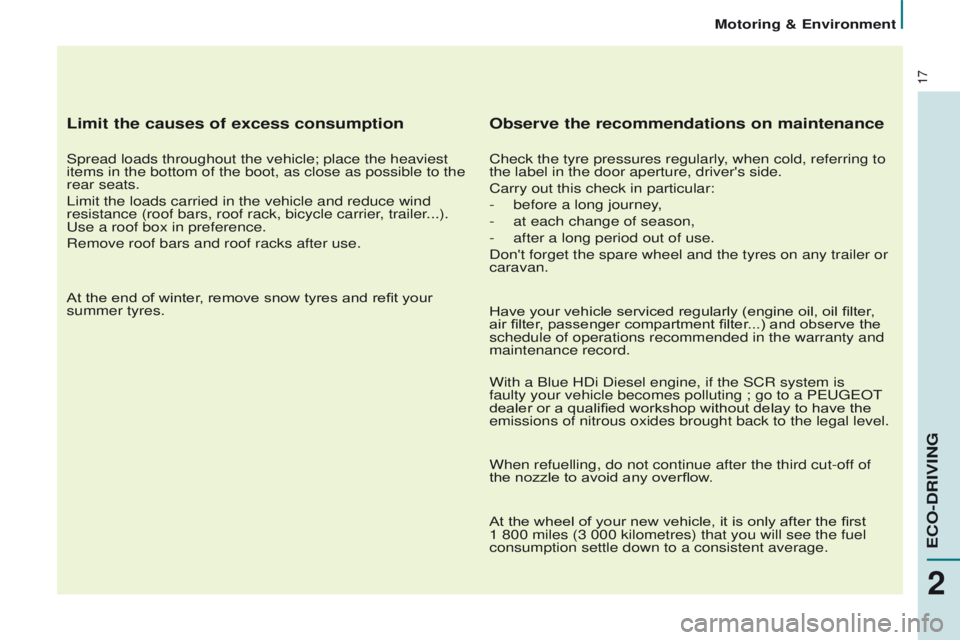2014 PEUGEOT PARTNER engine
[x] Cancel search: enginePage 5 of 244

3
Partner-2-VU_en_Chap00a_Sommaire_ed02-2014
corresponds to
a left hand drive
vehicle.corresponds to a
right hand drive
vehicle.
10.
TECHNOLOGY on
BOARD
6.
107-1
10
ACCESSORIES
7.
111-128
CHECKS
8.
129-149
QUICK HELP
Emergency or assistance 10.1
PEUGEOT
Connect
Navigation (RT6)
10.3PEUGEOT Connect Sound 10.59
T
owing a trailer
107
Other accessories
109
T
rade range
Telematic unit
Opening the bonnet
1
12
Petrol engine
1
13
Diesel engine
1
14
Levels
1
15
Checks
117
Fuel
119
Fuel cut-off
120
Diesel priming pump
120
AdBlue® additive and
SCR system
(BlueHDi Diesel)
121Battery
129
Changing a wheel
131
Removable
snow screen
135
Snow chains
136
Changing a bulb
137 a fuse
142 a wiper blade
146
Being towed
147
Precautions
148
9.
150-156
TECHNICAL
DATA
Dimensions 150
Engines 155
W
eights
155
Identification markings
156The "T
echnology on board"
section presents the new
audio/navigation systems.
P EUGEOT
Connect is the
name given to all of the
new equipment of the radio/
navigation range.
Contents
CONTENTS
Page 16 of 244

14
Partner-2-VU_en_Chap01_vue-ensemble_ed02-2014
TECHNICAL DATA - MAINTENANCE
Identification markings, serial number, paint code,
tyres
156
Snow chains
136
Windscreen / headlamp wash, levels
116
Changing bulbs, lighting
137-141 Checks
117-118
-
battery
,
-
gearbox,- air/passenger compartment filter,- oil filter,
-
particle filter ,
-
parking brake,
-
brake pads,
-
brake drums, discs.
Emissions controls
39
Engine fuses
142, 145
Under the bonnet: -
Diesel
1
14
-
petrol
1
13
Fuel cut-off, Diesel priming
120
AdBlue additive
121-128
Opening the bonnet, stay
1
12 Levels
1
15-116
-
Diesel additive,
-
dipstick,
-
power steering fluid,
-
brake fluid,
-
coolant.
Bleeding water
, Diesel filter
1
18
Warning lamps
30-37
Dimensions
150-153
Floor cab dimensions
154
Engines / W
eights
155
Location
Page 17 of 244

15
Partner-2-VU_en_Chap02_eco-conduite_ed02-2014
ENVIRONMENT
With you, PEUGEOT acts to protect
the environment.
We invite you to visit the
www.peugeot.co.uk website.As the driver, you also can contribute
to protecting the environment by
following certain rules:
-
adopt a preventive style of driving,
without frequent and harsh
acceleration,
-
observe the service intervals;
we recommend that services are
carried out by a PEUGEOT
dealer,
authorised to collect used batteries
and fluids,
-
in order to preserve the reliability
of the engine and emission control
systems, do not use engine oil
additives.Refer to information on eco-driving at
the end of this section.
2
ECO-DRIVING
Motoring & Environment
Page 18 of 244

16
Partner-2-VU_en_Chap02_eco-conduite_ed02-2014
Eco-driving is a range of everyday practices that allow the motorist to \
optimise their fuel consumption and CO2
emissions.
ECO-DRIVING
Optimise the use of your gearbox
With a manual gearbox, move off gently and change up
without waiting. During acceleration change up early.
With an automatic or electronic gearbox, give preference
to automatic mode and avoid pressing the accelerator
pedal heavily or suddenly.
The gear shift indicator invites you engage the most
suitable gear: as soon as the indication is displayed in the
instrument panel, follow it straight away.
For vehicles fitted with an electronic or automatic gearbox,
this indicator appears only in manual mode.
Drive smoothly
Maintain a safe distance between vehicles, use engine
braking rather than the brake pedal, and press the
accelerator progressively. These practices contribute
towards a reduction in fuel consumption and CO
2
emissions and also helps reduce the background traffic
noise.
If your vehicle has cruise control, make use of the system
at speeds above 25 mph (40 km/h) when the traffic is
flowing well.
Control the use of your electrical equipment
Before moving off, if the passenger compartment is too
warm, ventilate it by opening the windows and air vents
before using the air conditioning.
Above 30 mph (50 km/h), close the windows and leave the
air vents open.
Remember to make use of equipment that can help keep
the temperature in the passenger compartment down
(sunroof and window blinds...).
Switch off the air conditioning, unless it has automatic
regulation, as soon as the desired temperature is attained.
Switch off the demisting and defrosting controls, if not
automatic.
Switch off the heated seat as soon as possible.
Switch off the headlamps and front foglamps when the
level of light does not require their use.
Avoid running the engine before moving off, particularly in
winter; your vehicle will warm up much faster while driving.
As a passenger, if you avoid connecting your multimedia
devices (film, music, video game...), you will contribute
towards limiting the consumption of electrical energy, and
so of fuel.
Disconnect your portable devices before leaving the vehicle.
Motoring & Environment
Page 19 of 244

17
Partner-2-VU_en_Chap02_eco-conduite_ed02-2014
Limit the causes of excess consumption
Spread loads throughout the vehicle; place the heaviest
items in the bottom of the boot, as close as possible to the
rear seats.
Limit the loads carried in the vehicle and reduce wind
resistance (roof bars, roof rack, bicycle carrier, trailer...).
Use a roof box in preference.
Remove roof bars and roof racks after use.
At the end of winter, remove snow tyres and refit your
summer tyres.
Observe the recommendations on maintenance
Check the tyre pressures regularly, when cold, referring to
the label in the door aperture, driver's side.
Carry out this check in particular:
-
before a long journey
,
-
at each change of season,
-
after a long period out of use.
Don't forget the spare wheel and the tyres on any trailer or
caravan.
Have your vehicle serviced regularly (engine oil, oil filter
,
air filter, passenger compartment filter...) and observe the
schedule of operations recommended in the warranty and
maintenance record.
With a Blue HDi Diesel engine, if the SCR system is
faulty your vehicle becomes polluting ; go to a PEUGEOT
dealer or a qualified workshop without delay to have the
emissions of nitrous oxides brought back to the legal level.
When refuelling, do not continue after the third cut-off of
the nozzle to avoid any overflow.
At the wheel of your new vehicle, it is only after the first
1 800 miles (3 000 kilometres) that you will see the fuel
consumption settle down to a consistent average.
2
ECO-DRIVING
Motoring & Environment
Page 20 of 244

18
Partner-2-VU_en_Chap03_Pret-a-partir_ed02-2014
KEY
This locks and unlocks the doors on
the vehicle, opens and closes the
fuel filler cap, as well as starting and
stopping the engine.
Security of use
REMOTE CONTROL
Unlocking Unlocking the load spaceCentral locking
Press this button to lock the
vehicle completely.
The direction indicators flash once.
If one of the doors is open
(transportation of long loads) or is not
closed correctly, the central locking will
not work.
Deadlocking
A second press on the closed
padlock on the remote control within
five
seconds after locking changes the
locking to deadlocking.
This is confirmed by fixed lighting
of the direction indicators for
approximately two
seconds.
Deadlocking renders the exterior
and interior door opening handles
inoperative: do not leave anyone inside
the vehicle when it is deadlocked.
If deadlocking is activated from inside
the vehicle using the remote control, it
will change to normal locking when the
vehicle is started.
To unlock the load space only:
Press this control to unlock
the load space, the front
doors alone remain locked. Press this control to lock the
vehicle completely. Press this button to unlock all
of the rear doors.
Press this button once to
unlock the front doors.
Press this button again
to unlock your vehicle
completely.
The direction indicators flash twice.
Access
Page 22 of 244

20
Partner-2-VU_en_Chap03_Pret-a-partir_ed02-2014
Good practice
Do not make any modifications to the
electronic immobiliser system.
Operating the remote control, even
when it is in your pocket, may result in
involuntary unlocking of the doors.
The simultaneous use of other
high frequency equipment (mobile
telephones, domestic alarms…), may
interfere with the operation of the
remote control temporarily.
The remote control does not operate
while the key is in the ignition, even if
the ignition is off.
ELECTRONIC IMMOBILISER
All of the keys contain an electronic
immobiliser device.
This device locks the engine supply
system. It is activated automatically
when the key is removed from the
ignition.
After the ignition is switched on, a
dialogue is established between the
key and the electronic immobiliser
system.
The metal part of the key must be
unfolded correctly for correct dialogue
to take place.
If you lose your keys
Visit a PEUGEOT dealer with the
vehicle's V5 registration document and
your identification document.
A PEUGEOT dealer will be able
to retrieve the key code and
the transponder code so that a
replacement key can be ordered.When leaving the vehicle, check that
the lamps are off and nothing of value
is visible.
As a safety precaution (with children
on board), remove the key from the
ignition when leaving the vehicle, even
for a short time.
When purchasing a
second-hand
vehicle:
-
have the keys memorised by a
PEUGEOT
dealer to ensure that
the keys in your possession are
the only ones which can start
the
vehicle.
ALARM
If fitted on your vehicle, this provides
two types of protection:
-
exterior protection: it sounds if a
front/rear door or the bonnet is
opened.
-
interior protection: it sounds if
the volume inside the passenger
compartment changes (breaking of
a window or a movement inside the
vehicle).
If
your vehicle is fitted with a separation
partition, the interior protection is not
active in the load space.
Locking the vehicle with
complete alarm
Setting the alarm
- Switch of f the ignition and get out of
the vehicle.
-
Set the alarm within five minutes of
getting out of the vehicle, by locking
or deadlocking using the remote
control.
The red LED, located in the
button, flashes once per
second.
Access
Page 29 of 244

27
Partner-2-VU_en_Chap03_Pret-a-partir_ed02-2014
Driving with the doors locked may
make access to the interior more
difficult in an emergency.
CENTRAL LOCKING
Cab and load spaceLoad space
Locking while driving
When the vehicle moves off, as soon
as you reach approximately 6 mph
(10
km/h), the system locks the doors.
The characteristic central locking noise
is heard. The LED in the control switch
on the dashboard central switch panel
comes on.
During the journey, opening a door
results in complete unlocking of the
vehicle.
Anti-intrusion protection
An initial press locks the front
and rear doors, when they
are closed.
A
second press unlocks the
vehicle.
The control switch is inactive when
the vehicle has been locked using
the remote control or the key from the
outside. Activating
/ deactivating the
function
With the ignition on, press
and hold this switch to
activate or deactivate the
function.
Door open warning lamp If this warning lamp comes
on, check that all of your
vehicle's doors are closed
correctly.
Press to lock/unlock
the rear
doors without
changing
the locking status of
the cab.
The doors can still be opened from
the
inside.
The control switch LED:
-
flashes when the doors are locked with
the vehicle stationary and the engine of
f,
-
comes on when the doors are locked
and from the time the ignition is
switched on.
Access
READY TO SET OFF
3